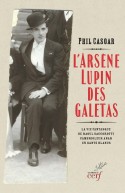Aimé-Georges Martimort
Collection Cerf Histoire
352 pages - déc. 2011
34,10€
C'est la première fois qu'un ouvrage est consacré à l'œuvre de Mgr Aimé-Georges Martimort [1911-2000], dont le nom et l'œuvre restent définitivement attachés à la réforme liturgique issue du concile Vatican II. Ce prêtre toulousain, artisan infatigable d'une entreprise qui demeure jusqu'à présent unique dans l'histoire de l'Église, a su tracer la route aux pasteurs et aux communautés chrétiennes dans ce mouvement de réforme qu'il les invitait à aborder avec enthousiasme et réalisme, mais aussi dans la fidélité à la tradition vivante de l'Église, comme en témoigne l'ouvrage majeur réalisé sous sa direction, « L'Église en prière ». Or, l'expert du Concile s'est, à son insu, préparé et façonné dans la formation reçue, dans les activités exercées et dans la notoriété acquise pendant les cinquante premières années de sa vie, auxquelles est consacrée la présente étude. Celle-ci peut illustrer cette loi constante de l'histoire qui veut qu'une grande œuvre soit issue de la rencontre d'une personnalité de valeur avec une conjoncture indépendante de sa volonté, mais dont elle a su tirer parti pour réaliser un idéal qu'elle portait en elle et que, sans aucun doute, elle ignorait au départ. En effet, Aimé-Georges Martimort s'est trouvé, comme mû par un secret destin, au point central de plusieurs mouvements liturgiques puissants nés durant l'entre-deux-guerres où, distingué pour ses aptitudes, il a été appelé à servir. Afin de rendre compte des diverses facettes de son œuvre et des étapes de son cheminement, ce livre évoque sa formation marquée par des rencontres significatives, son action au Centre de pastorale liturgique [CPL] à Paris et l'animation qu'il y a déployée en tant que codirecteur, la manière dont il a conçu sa fonction de professeur dans le cadre universitaire ou au service d'organismes de formation, et enfin sa réflexion sur un sujet qu'il a particulièrement approfondi : l'assemblée liturgique.
--
For the first time, a book devoted to the work of Mgr. Aimé-Georges Martimort [1911-2000], whose name and works remain permanently associated with the liturgical reform of Vatican II. This priest from Toulouse, a tireless worker for a project that remains unique in the history of the Church, traced out the path for pastors and Christian communities in the reform movement, inviting them to follow with enthusiasm and realism, but also in fidelity to the living tradition of the Church; as the major work achieved under his direction – “L'Église en prière” – testifies. Yet unknown to him, he had already been prepared and shaped for his work on the Council by the training he received during his activities, and by the renown he gained during the first fifty years of his life, to which this study is devoted. Here is an illustration of that eternal law: a great work is the fruit of a meeting between a worthy person and a situation beyond his own control, which the person nevertheless succeeds in making the best of, to realize an ideal he had always held dear, even though he was certainly unaware at the outset. In truth, Aimé-Georges Martimort found himself, as though moved by a secret fate, at the centre of several powerful liturgical movements born between the two wars and in which he was called to serve, his aptitudes for these tasks being well-recognized. To recount the diverse facets of his work and the different stages of his progress, this book evokes his training, which was marked by significant meetings; his action at the Centre de pastorale liturgique [CPL] in Paris and his activities there as co-director; his conception of his function as a teacher in the university context and in the service of training establishments; and lastly, his reflection on a subject about he had considered deeply: the liturgical assembly.
--
For the first time, a book devoted to the work of Mgr. Aimé-Georges Martimort [1911-2000], whose name and works remain permanently associated with the liturgical reform of Vatican II. This priest from Toulouse, a tireless worker for a project that remains unique in the history of the Church, traced out the path for pastors and Christian communities in the reform movement, inviting them to follow with enthusiasm and realism, but also in fidelity to the living tradition of the Church; as the major work achieved under his direction – “L'Église en prière” – testifies. Yet unknown to him, he had already been prepared and shaped for his work on the Council by the training he received during his activities, and by the renown he gained during the first fifty years of his life, to which this study is devoted. Here is an illustration of that eternal law: a great work is the fruit of a meeting between a worthy person and a situation beyond his own control, which the person nevertheless succeeds in making the best of, to realize an ideal he had always held dear, even though he was certainly unaware at the outset. In truth, Aimé-Georges Martimort found himself, as though moved by a secret fate, at the centre of several powerful liturgical movements born between the two wars and in which he was called to serve, his aptitudes for these tasks being well-recognized. To recount the diverse facets of his work and the different stages of his progress, this book evokes his training, which was marked by significant meetings; his action at the Centre de pastorale liturgique [CPL] in Paris and his activities there as co-director; his conception of his function as a teacher in the university context and in the service of training establishments; and lastly, his reflection on a subject about he had considered deeply: the liturgical assembly.
- Dimensions : 145x235x20
- ISBN : 9782204095334
- Poids : 520 grammes
Avec la collaboration de : Robert Cabié







